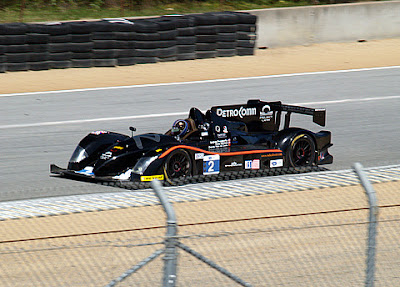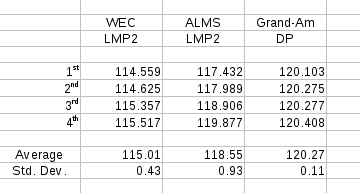UPDATE: the Fuji WEC race has been moved to Oct. 12th. The figure above has been changed to reflect this.
UPDATE (31 Jan 2014): the Sao Paulo WEC round has been moved from Aug 31 to Nov 30. The figure above has been changed to reflect this.
TIP: Click on the image above. Once you have the enlarged image right-click and save the image to your desktop. Now you have a basic reminder of upcoming races every time you start your computer.
I have published two public Google calendars with this information and more available in three formats (HTML, XML, iCal), one for the ACO rules races (WEC and ELMS) and one for the IMSA TUSC races:
ACO Racing 2014 links: HTML, XML, iCal
TUSC Racing 2014 links: HTML, XML, iCal
These can be used directly from a browser, in Apple's calendar program, in Thunderbird/Lightning, and other calendar applications. You can find instructions for use of Google calendar with several popular applications here.
As more detail is provided by the organizers, these calendars will be updated to include event times, coverage etc. For those who are already using the calendars I published previously, those links are being re-used with new names. Last year's "ACO Racing 2013" becomes next year's "ACO Racing 2014" and last year's "Grand-Am 2013" becomes "TUSC Racing 2014" (since TUSC no longer conforms to ACO rules). If and when any information comes out about the Asian Le Mans series, it will be added to the ACO calendar. As always the times will be for U.S. Eastern Time, with race local times included along with other details in the "Description" field.
Over on the Radiolemans.com forum, James Hazen has been collecting news of TUSC entries for 2014. This list is based on team announcements and press releases. It is being actively updated. You can find the list here.
Media Coverage
It is expected that video for both ELMS and WEC races will be streamed live on Dailymotion.com as in previous years. If this last year is any guide, commentary on these streams will be provided by the Radiolemans.com team, but so far there is no confirmation of this. The full range of TUSC coverage is still a bit of a mystery. Last August the 5-year deal with Fox Sports was announced. This deal covers broadcast rights in the U.S. as well as streaming rights. IMSA retains some streaming rights and streaming on demand for archived video. If it works like last year's ALMS arrangement whereby IMSA can stream video of races live for the "International" audience, then all will be well; but I have my doubts. Live streaming arrangements have not been finalized. Since I can't get Fox Sports from my local cable monopoly, I am dependent on the Internet for any race coverage.
Grand-Am had Speed TV (now Fox Sports) coverage (mixed live and delayed telecasts) as well as audio-only coverage via MRN Internet radio. The only streaming video coverage was on-demand from their archives after the races were broadcast. It was painfully obvious that the MRN coverage was far inferior to the coverage of WEC and ELMS races by Radiolemans.com. The archived Speed videos were good quality, but since I couldn't get Speed TV, I saw none of the Grand-Am races live. If TUSC follows this model rather than the ALMS model, I predict there will be a widespread loss of fan-base.
I feel very strongly that if IMSA/TUSC wants to preserve and grow their fan-base, they would open up their media coverage as much as possible. Radiolemans.com's interactive broadcasts were an important feature of the ALMS for over a decade and in my opinion were responsible for attracting quite a number of International fans to the ALMS, including myself.
I would be willing to pay a nominal fee for live streaming race coverage. The ESPN player I have used in the past was less than $5.00US for the entire ALMS season. At twice that price it would still be a bargain, and a lot more practical than somehow convincing my local cable monopoly to add Fox Sports to their channel list then paying some exorbitant price per month for a "bundle" of channels I don't want.
Here is the "How to Watch" FAQ from the IMSA site:
How to Watch - FAQs
On what channel can I find IMSA TUDOR United SportsCar Championship races?
All TUDOR Championship races can been seen on FOX Sports 1 or FOX Sports 2.
What do I do if I don't get FOX Sports 1 or FOX Sports 2?
Contact your local cable provider.
Is online streaming available?
Online streaming is not available at this time, but will be in the future.
Where can I watch archived races?
Archived races will be available on IMSA.com 24 hours after the broadcast on FS1 or FS2
I feel very strongly that if IMSA/TUSC wants to preserve and grow their fan-base, they would open up their media coverage as much as possible. Radiolemans.com's interactive broadcasts were an important feature of the ALMS for over a decade and in my opinion were responsible for attracting quite a number of International fans to the ALMS, including myself.
I would be willing to pay a nominal fee for live streaming race coverage. The ESPN player I have used in the past was less than $5.00US for the entire ALMS season. At twice that price it would still be a bargain, and a lot more practical than somehow convincing my local cable monopoly to add Fox Sports to their channel list then paying some exorbitant price per month for a "bundle" of channels I don't want.
Here is the "How to Watch" FAQ from the IMSA site:
How to Watch - FAQs
On what channel can I find IMSA TUDOR United SportsCar Championship races?
All TUDOR Championship races can been seen on FOX Sports 1 or FOX Sports 2.
What do I do if I don't get FOX Sports 1 or FOX Sports 2?
Contact your local cable provider.
Is online streaming available?
Online streaming is not available at this time, but will be in the future.
Where can I watch archived races?
Archived races will be available on IMSA.com 24 hours after the broadcast on FS1 or FS2
I will have to wait and see what their online streaming product is and keep my fingers crossed.









